Past, Present, and Future Praxis of Black Liberation: Juneteenth and Beyond
In recognition of Juneteenth, Black Artist Research Space presents a non-exhaustive resource list and compilation of books, music, artwork, exhibitions, and movements that exemplify the spirit of triumph prevalent within the Black community. The selected works featured within this source list serve as indication and active example of how Black people have done and continue to actively take a principle role in the freeing of one’s self and one’s community. While systems of oppression might persist, we continue to create spaces for uninhibited joy and celebration.
START HERE
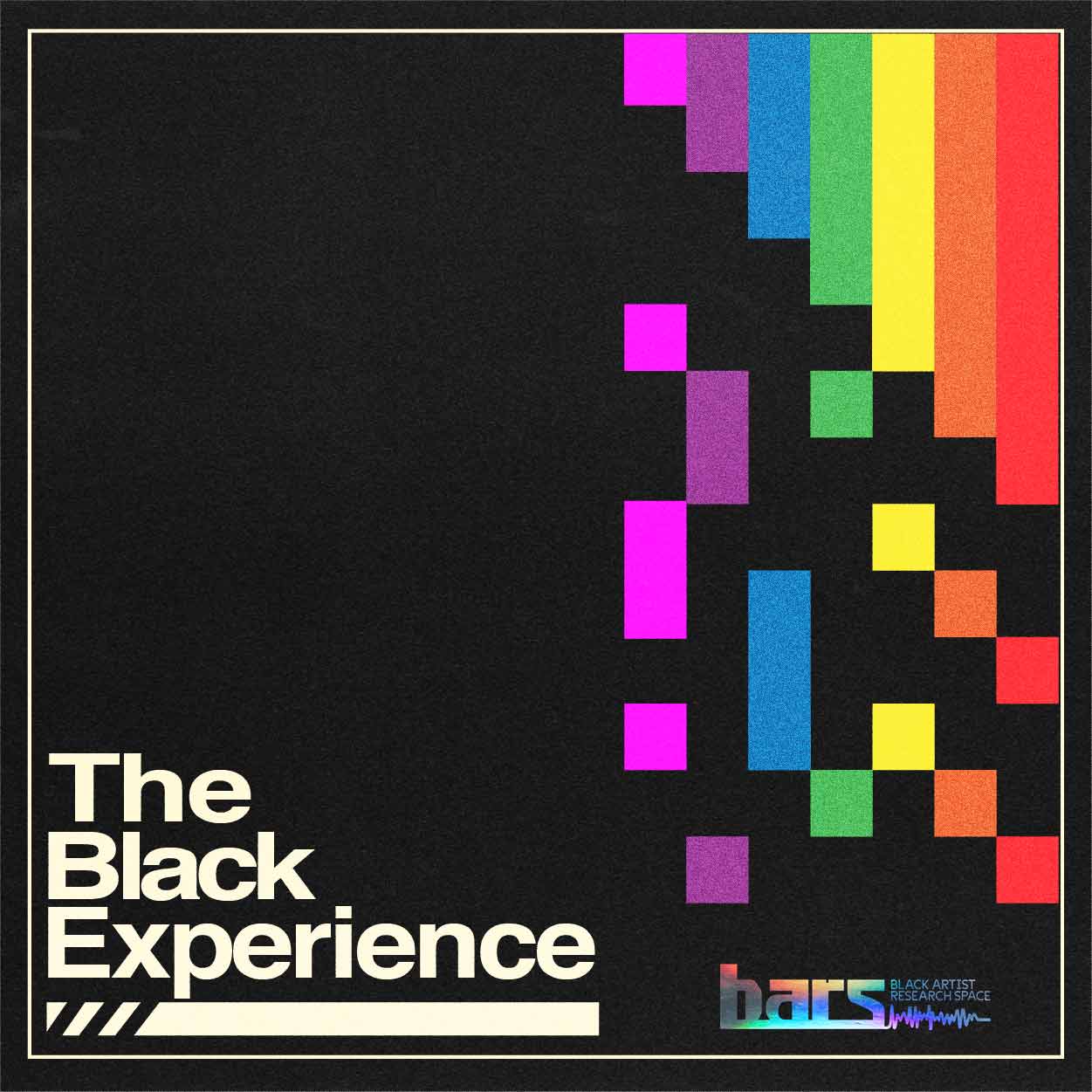
Maryland based DJ/Producer Koleco brings together a large variety of black musicians to create a mesmerizing playlist full of angelic voices, hard hitting lyrics, funky groves and much more.
By recognizing the true essence of Juneteenth, Koleco believes the fight for freedom and expression plays a big role in today's beautiful creation within black creative imagination.
Welcome to The Black Experience!
~Koleco
MUSIC
Inspired by the memory of Lorraine Hansberry and her play of the same name, Young, Gifted, and Black , Simone’s 1970 song is a mantra of affirmation to Black children and the Black community.
Sam Cooke released “A Change is Gonna Come” in 1964 following personal incidents of racism and a desire to write a song that spoke to the experience of African Americans and the Civil Rights Movement.
"Lift Every Voice and Sing", also referred to as the Black or Negro National Anthem, is a poem written in 1900 by James Weldon Johnson which describes the gloom and triumphs of the Black experience. Later set to music by John Johnson, the song generated approval by noted Black figures such as Booker T. Washington, and in 1919 became the official song of the NAACP.
“This is America” by Childish Gambino is a song and visual riddled with symbolism that explores the troubling dualities of Blackness as a result of historical and prevailing racial conditions, police brutality, and gun violence within the United States.
Originally written, recorded, and released by Bob Marley and The Wailers in 1979, “Redemption Song” explores mental freedom and liberation, with reference to the 1937 speech ‘The Work That Has Been Done” by orator Marcus Garvey. Ziggy Marley and Lauryn Hill later performed the song together in 1999 in Oracabessa Bay.
"Afro-American Symphony" is a symphony written by William Grant Still, an African American composer who broke barriers by becoming the first Black conductor of a major U.S. Symphony Orchestra (Rochester Philharmonic Orchestra). The
song's progressions are characteristic of the intentionality Still had for evoking the African American spirit within his compositions. African American musical styles such as Negro spiriuals, jazz, and blues are evident across the four
movements of the symphony.
Paul Laurence Dunbar's poem “Ode to Ethiopia," follows the fourth movement:
Be proud, my Race, in mind and soul,
Thy name is writ on Glory's scroll
In characters of fire.
High 'mid the clouds of Fame's bright sky,
Thy banner's blazoned folds now fly,
And truth shall lift them higher.
"Liberation” is featured on Outkast’s 1998 third studio album and features a combination of African American musical styles ranging from gospel, jazz, hiphop, and in parts connects the oral traditions of poetry to contemporary rap. Black liberation serves as the main topic throughout the song and also features artists Cee-Lo Green, Erykah Badu, and poet Big Rube. The song explores the journey to Black liberation in the midst of contending with structures and realities intended to keep one bonded to stagnation.
“Alright” is a song and subsequent mantra written by Kendrick Lamar in 2015. Rising in popularity in 2015 during ongoing Black Lives Matter protests across the United States, the track elicits a sense of solidarity and assuredness. Though instances of brutality and oppression exist, an unwavering confidence and hope in what the future holds persists.
“What’s Going On?” is the 1971 protest song written and performed by Marvin Gaye. Inspired by police brutality, the Vietnam War, and race riots ongoing in the United States, Gaye suggests love as the answer and remedy.
“Blk Girl Soldier” is a song written and performed by Jamila Woods in 2016. Woods explains the plight of Black women throughout history, even referencing some activists such as Sojourner Truth and Angela Davis in her song. Although she speaks of the suffering of Black women in America, she also focuses on themes of empowerment and freedom.
“Reyna’s Interlude” is a spoken word interlude on Rapsody’s 2019 album Eve and performed by poet Reyna Biddy. The interlude directly addresses Black women, remarking on the collective beauty and strength present through the pain and trauma experienced by Black women.
“Alabama” is a 1964 jazz song composed and performed by Coltrane along with McCoy Tyner, Jimmy Garrison, and Elvin Jones. It was written as a tribute to the four young Black girls killed in a church bombing by the KKK in Birmingham, Alabama. Coltrane created a song that would forever memorialize the lives of Addie Mae Collins, Cynthia Wesley, Carole Robertson, and Carol Denise McNair.
“U.N.I.T.Y” is a hip-hop song written by Queen Latifah and her producer Kay Gee, which was released in 1993 and performed by Latifah. In this song, Queen Latifah voices her concerns and experiences of misogyny and assault against women in Black communities. As she calls to action for unity within her community, she reclaims harmful sexist terminology and spins it on its head.
“Fly Girl Get’em” is a 2012 song written and performed by BJ The Chicago Kid, also known as Bryan James Sledge. In the song, Sledge voices his love and appreciation of Black women. “Fly Girl Get’em” serves as a sign of support and empowerment for natural beauty.
ARTWORK

Inspired by Martin Luther King Jr.’s 1963 “I Have A Dream” speech, this lithograph by artist Charles White depicts the connection and reverence between a Black mother and child. The title of the work speaks to the future that Black mothers envision for their children and lineage.
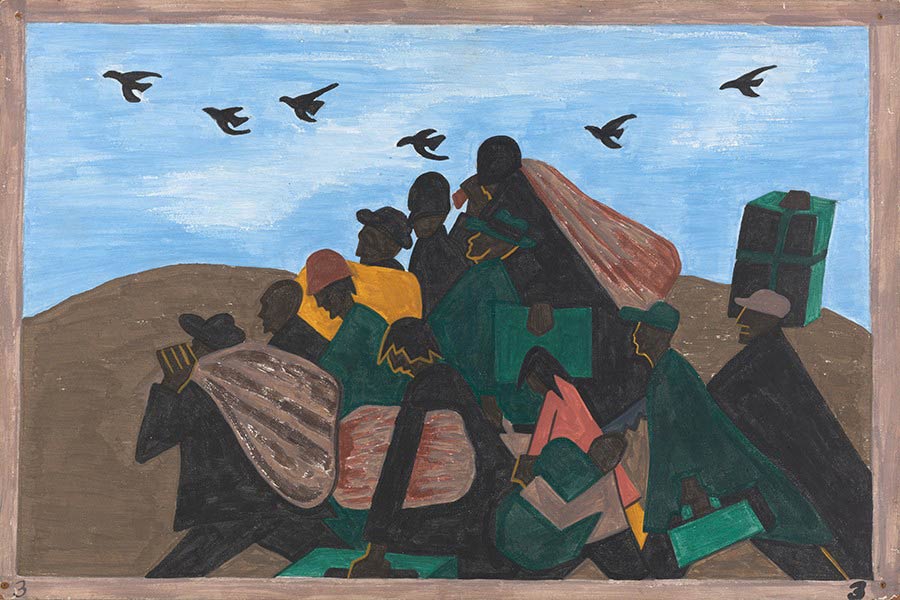
The “Migration Series” by painter James Lawrence is a collection of 60 individual paintings depicting the mass migration of African Americans from the South. During World War I, Southern African Americans left their homes in record numbers to build new lives with economic promise in Northern cities such as Detroit, New York, Chicago, and St. Louis.
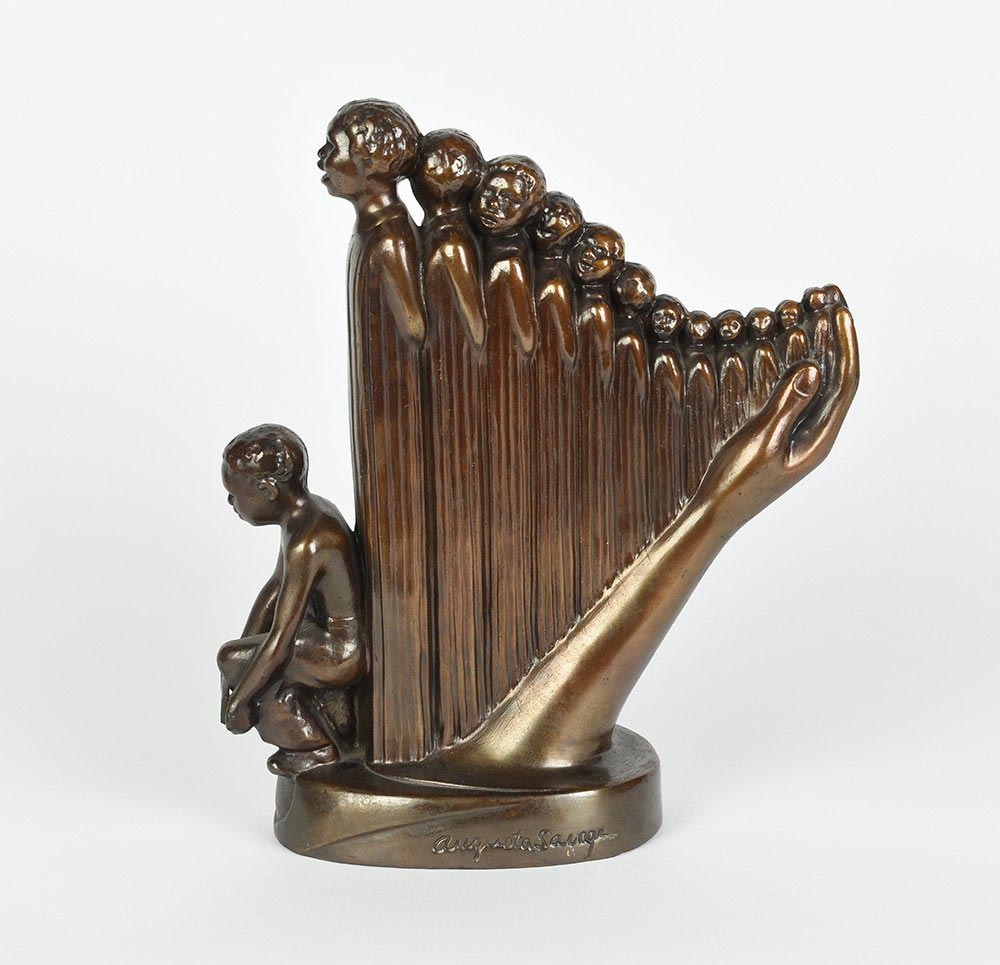
“I have created nothing really beautiful, really lasting, but if I can inspire one of these youngsters to develop the talent I know they possess, then my monument will be in their work.”—T. R. Poston, “Augusta Savage,” Metropolitan
Magazine, Jan. 1935, n.p.
Originally titled Lift Every Voice and Sing, Augusta Savage’s 1939 World’s Fair commission, “The Harp”, symbolizes the Black American experience as revealed in James Weldon Johnson’s poem of the same name.
The once 16 foot plaster statue created in Savage’s Harlem studio depicts twelve Black robed figures with their mouths open in a singing-like position under the hand of God. The composition of “The Harp” alludes to the legacy of Black
music traditions, the connected struggle of Black people, and our quest for liberation. The sculpture asserts that progress for the group is obtainable. Savage’s contributions both as educator and artist helped to establish a legacy of
Black artists whose work is reflective of valued communal practices, evident in the legacy and inspiration of "The Harp".
Smaller bronze versions of the statue were later created by Savage.
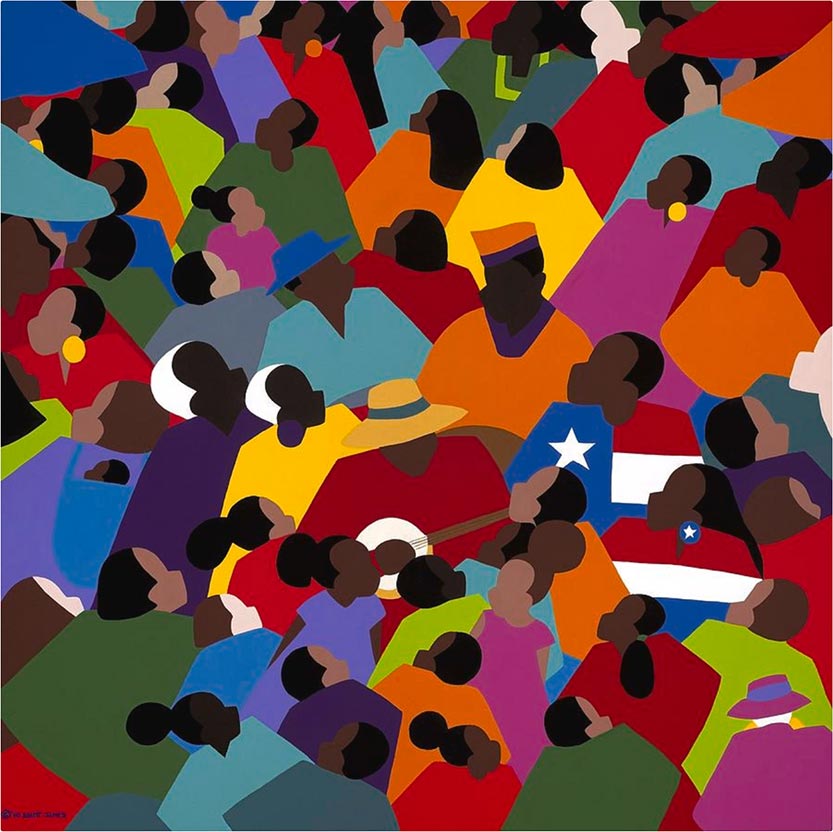
Painted by self-taught artist Sythia Saint James, Juneteenth is a colorful depiction of celebration amongst Black people in observance of the June 19, 1865 enforcement and announcement of the 1863 Emancipation Proclamation by Union troops to the last enslaved African Americans. Copyright 2010 Synthia Saint James. www.synthiasaintjames.com

America Free Angela (1971) is a lithographic ink on cardboard with mat board by artist Faith Ringgold. Ringgold created this work in response to the arrest of activist Angela Davis. The prints inspired by the Kuba tribe of Central Africa were produced and sold to support student and community causes. The text “Free Angela” and “Free America” can be noted in the composition.

In “Homeland Sweet Homeland”, artist Nari Ward uses found objects associated with protest and police in order to highlight themes often related to the Black American experience. Ward is a Jamaican-born immigrant, who migrated to the U.S as a youth and pursued art studies in New York. Ward’s work centers around themes connected to consumerism, race, and immigration.

"Fons Americanus” is a sculpture created by Kara Walker that explicitly depicts the trials and tribulations of enslaved African people in relation to the Trans-Atlantic slave trade. Walker often uses visual allegory to explain issues relating to race, slavery, and diaspora. She is most known for her use of silhouettes and black cut outs to create large-scale scenes of the antebellum period in the southern U.S.
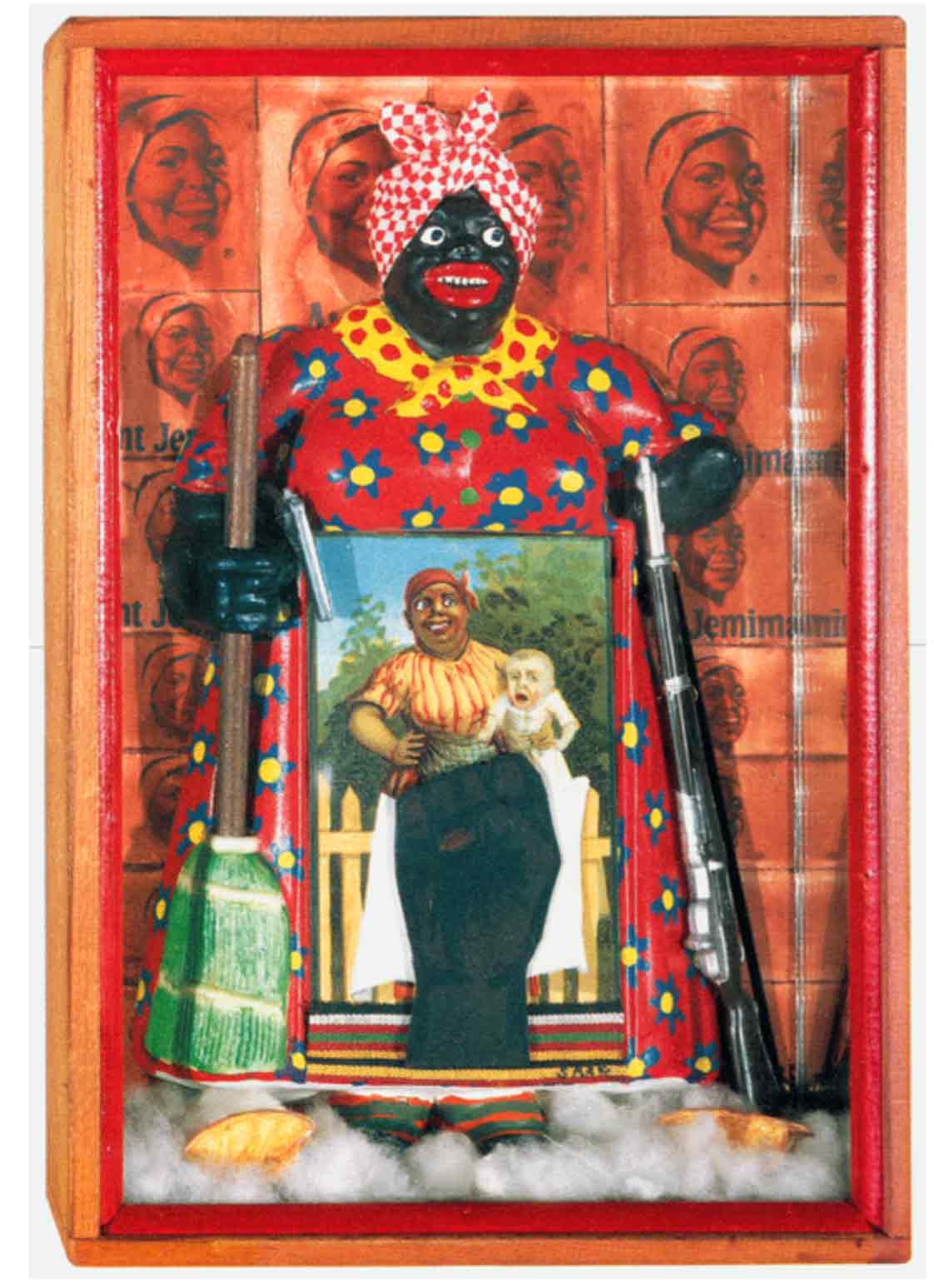
"The Liberation of Aunt Jemima” by artist Betye Saar depicts the historically derogatory “mammy” figure in a powerful and warrior-like fashion. While the traditional mammy figure and stereotype is considered subservient and compliant, the figure that Saar creates wields a rifle in her left hand. The rifle serves as an indication of the rejection of the conditions and roles that have kept Black people oppressed and enslaved.

"The Liberation of Aunt Jemima and Uncle Ben” by artist and photographer Renee Cox depicts Cox, front and center as a Black superhero who is actively rescuing the stereotypes of African Americans that capitalism exploits to fuel sales and systemically racist structures.

Faith Ringgold’s “United States of Attica” was created in memory of the 1971 Attica Prison uprising in which inmates were demanding humane treatment, inmate rights, and freedom while incarcerated. Ringgold invited participants to fill in additional incidents of violence, including war, enslavement, and race-riots within the United States. The colors of the map, red, green, and black, reflect the traditional colors of the Pan-African flag.
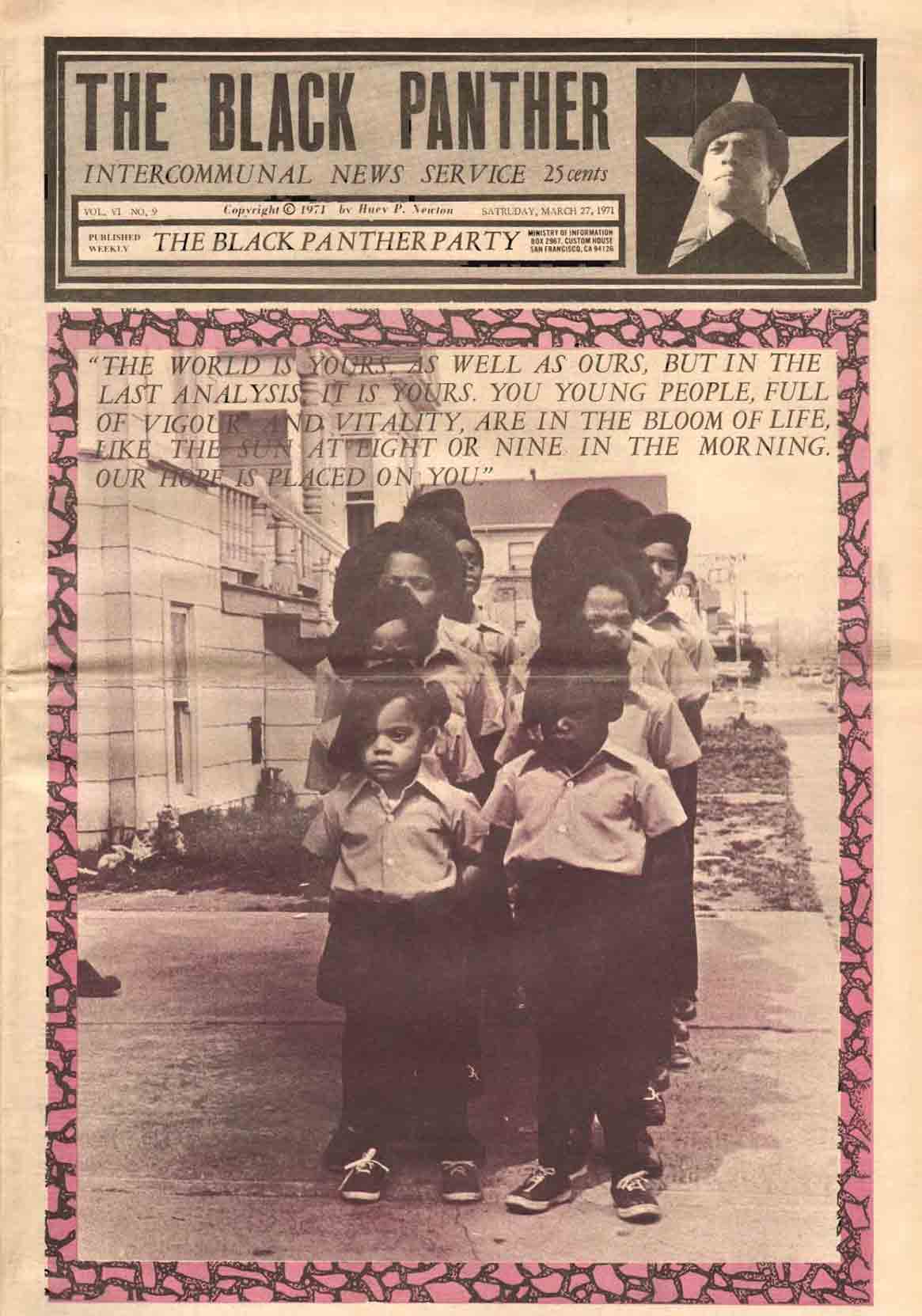
Emory Douglass is a graphic designer and the former Minster of Culture for the Black Panther Party. Beginning in 1967, the Black Panther Party produced a periodical publication (the “Intercommunal News Service”, also known as the “Black Community News Service”) in which events and news relevant to the Party and the community were disseminated. Emory Douglass created the layouts as well as the notable designs within the publication and for the Party.
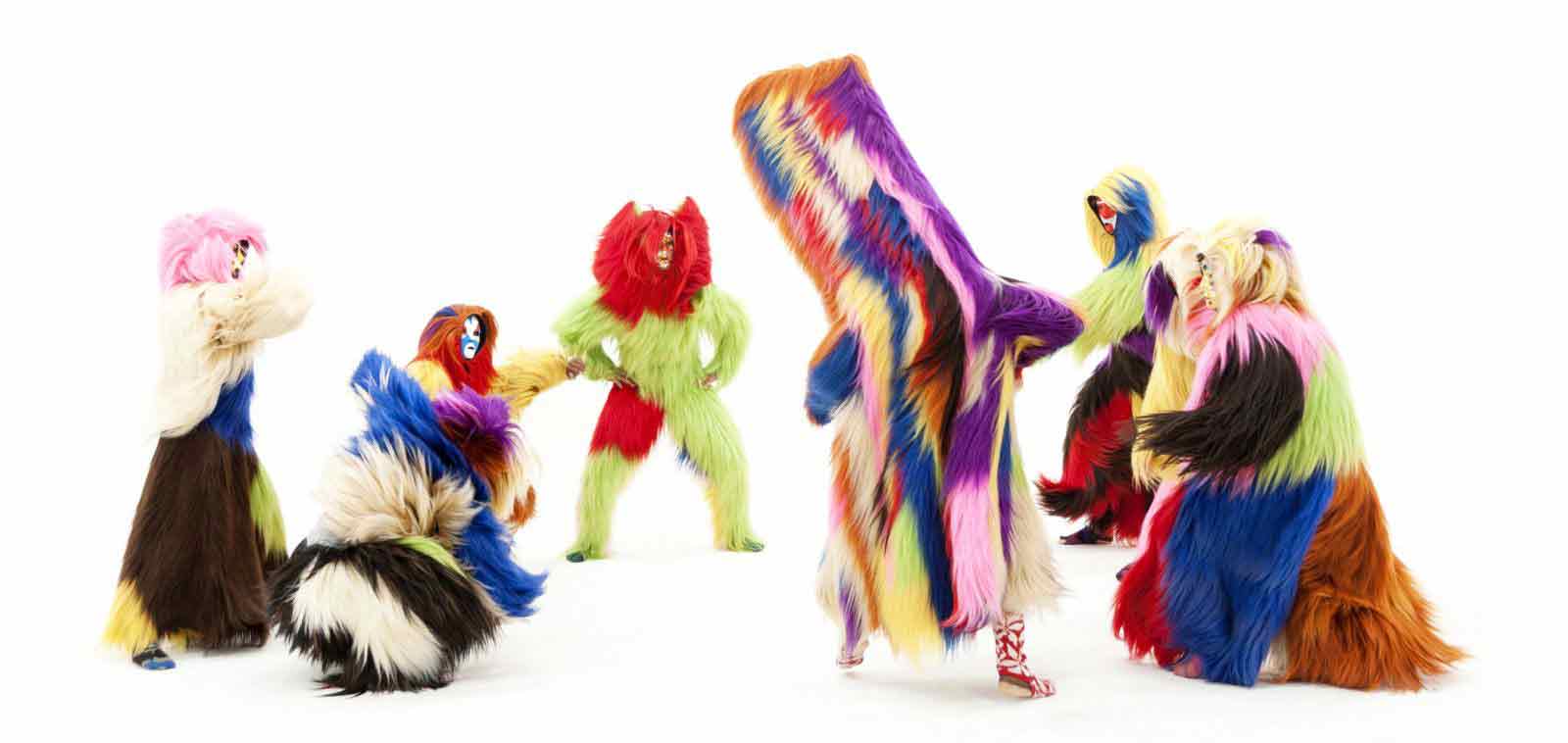
Nick Cave is an American artist who uses textiles, found objects, costume, and performance to speak about race, tradition, and movement. Cave created these soundsuits to cover an entire person’s body, while creating sound as the individual wearer interacts with the garment. He has been creating these pieces since the late 90s and continues to build upon the series by using different materials and relating them to other social issues such as gun violence and climate change.
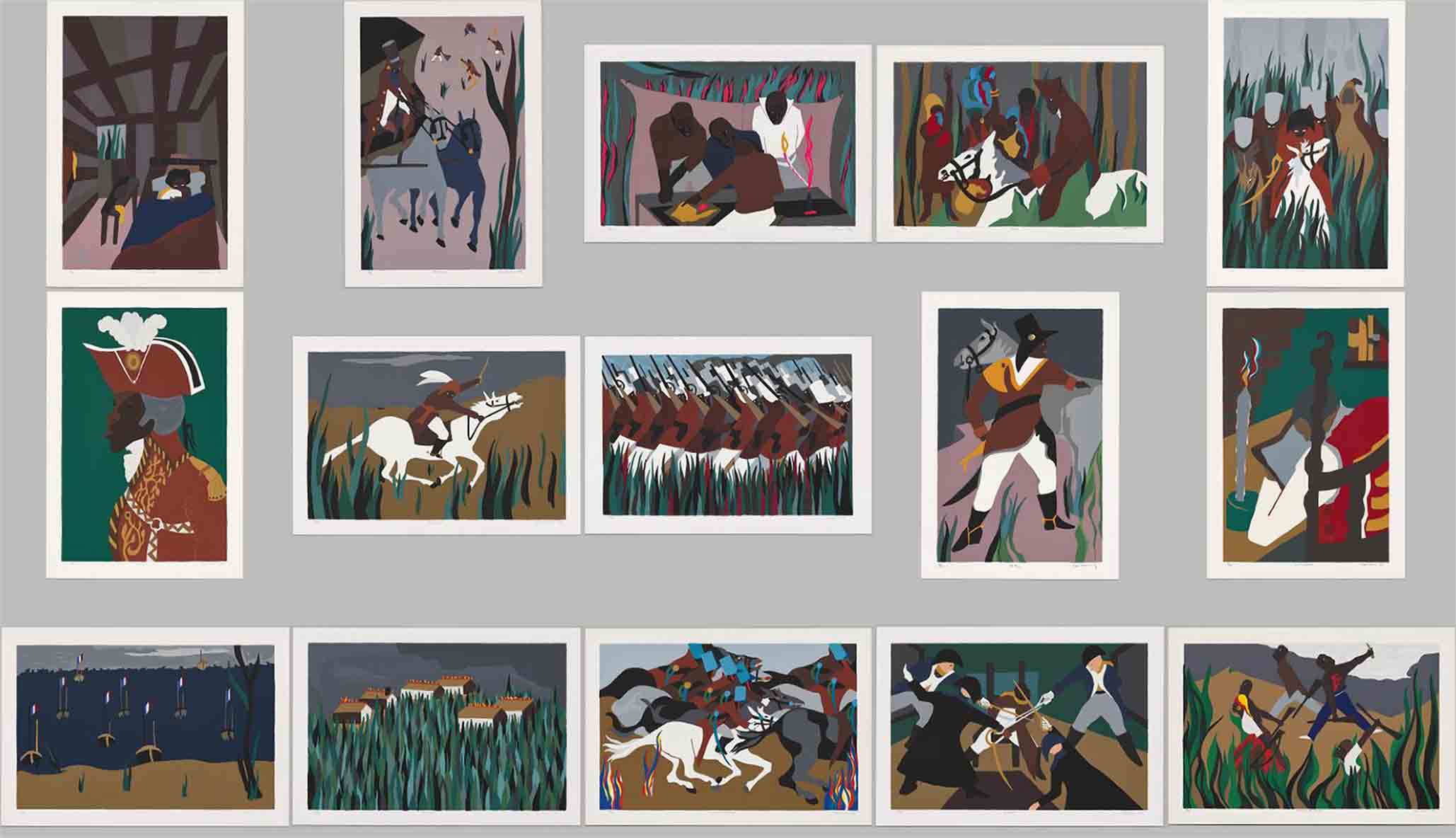
“The Life of Toussaint L’Ouverture" is a series of prints by African American artist Jacob Lawrence that depict the life events of Hatian Revolutionary Toussant L’Ouverture. L’Ouverture led Haiti in a revolution against the French between 1791 - 1804 that resulted in Haiti’s victory and declaration of independence.
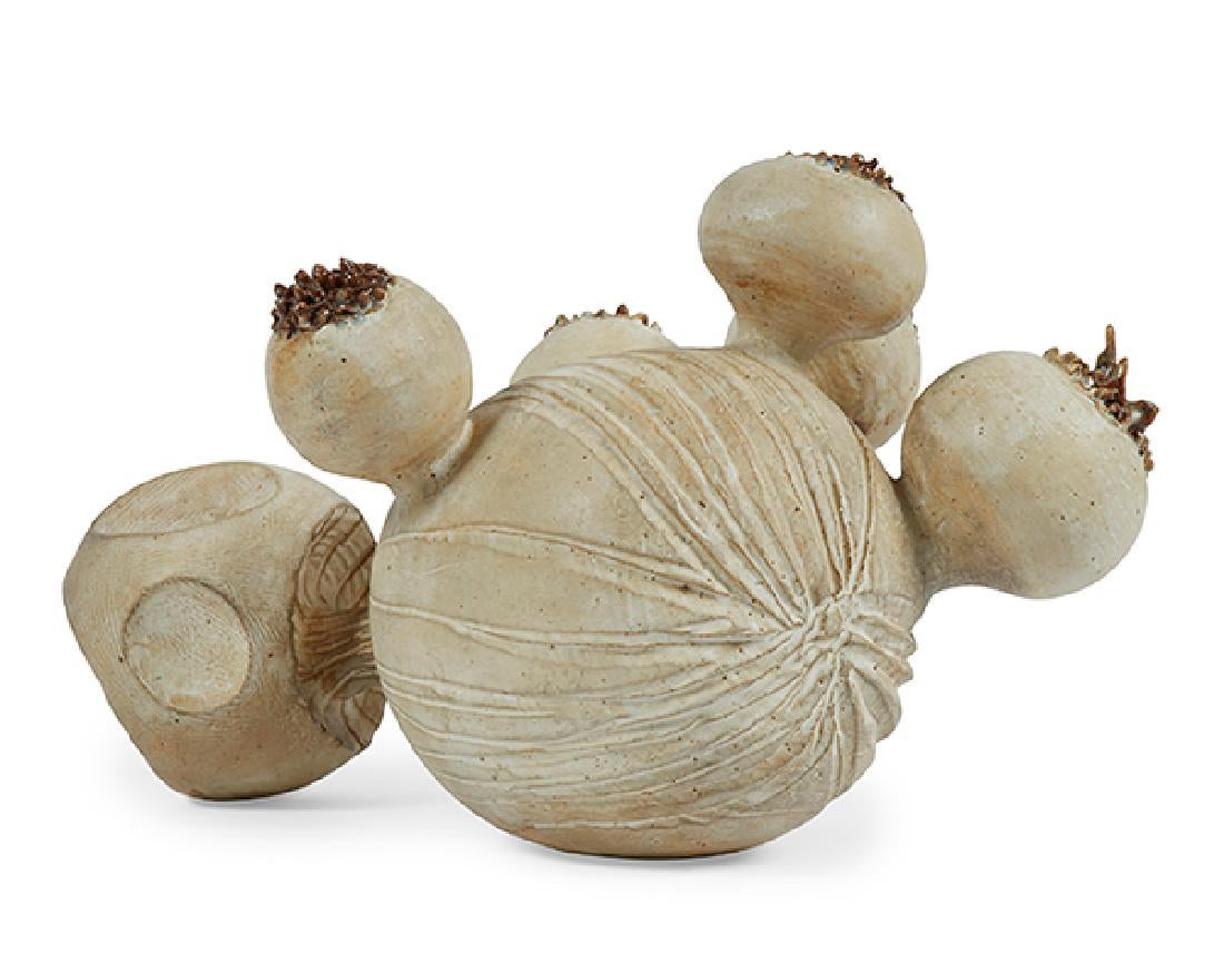
Ceramicist Earl Hooks (1927-2005) was born and raised in Baltimore, MD. Hooks received his BA from Howard University in 1949 and was both a professor and chair of the Fisk University Art Department from 1961-1967. His sculptures often reflect on the Black experience through their technical use of balance, form, light and space. Earl Hooks work pushes the bounds of technique in order to explore the diverse experience of this group which has in itself progressed the Black aesthetic. In doing so his work reveals a deeper and even instinctual connection to his subject matter.

Brick House (2019) is a 16-foot (4.9 m) tall bronze bust of a Black woman by Simone Leigh, installed along the High Line in New York City.
"Art Thoughtz: How To Be A Successful Black Artist" is an instructional video created by and featuring artist Jayson Musson aka Hennessy Youngman. Through dialogue directed towards his subject,"inanet", Musson reveals what Claudia Rankine in Citizen describes as a type of knowledge Black people carry that both clarifies and disappoints. "Art Thoughtz" (2010-2012) is a series of Youtube videos where Hennesy Youngman speaks to topics related to contemporary art.
SPEECHES/POEMS
“Still I Rise” by poet Maya Angelou explores themes relevant to confidence and self-esteem and how these traits are critical to continued resilience and liberation.
“Haiku and Tanka for Harriet Tubman” by poet Sonia Sanchez urges readers to recount the acts of bravery and leadership exemplified by abolitionist Harriet Tubman throughout her life and quest for freedom while conducting the Underground Railroad.
“won’t you celebrate with me” by poet Lucille Clifton acknowledges the duality of experiences Black women endure. While faced with oppressive systems and equip with no blueprint on how to exist as a Black woman in American, Black women still manage to survive. This notion, Clifton notes, is cause for celebration.
On July 5, 1852 Frederick Douglas gave one of his most famous speeches, “The Meaning of July Fourth for the Negro” addressed to the Rochester Ladies Antislavery Society.
“We Wear the Mask” is a 1895 poem written by the late 19th century poet and novelist Paul Laurence Dunbar. The poem explores the dual existence of African Americans, in which Dunbar refers to as wearing a mask, never to reveal the truth of what’s underneath. This duality is similarly expressed as double consciousness by W.E.B. Du Bois in The Souls of Black Folk (1903).
“Coal” is a poem which takes its title from Audre Lorde’s collection of poetry published in 1976 which focuses on themes of identity connected to Black womanhood, sexuality, lesbianism, and other topics central to the artist’s own life. Written in first person, “Coal” reveals Lorde’s exploration of self through the metaphorical use of coal and its relationship to diamonds.
“Ka’Ba” is a 1969 poem written by poet and playwright Amiri Barak. Baraka creates a visual scene for his viewers, one that depicts the reality Black people have come to live and experience as people of the diaspora in the United States. It’s here that the Bakraka turns the poem into a call to action, as the state Black people are in is not the state of our origin or creation. The call to action Baraka creates urges the Black community to recall the lands, language, and ways of living that are innate to us culturally and spiritually.
MOVEMENTS + ORGANIZATIONS
The Black Arts Movement, established in 1965 by poet and playwright Amiri Baraka gave way to a community of Black artists who served to ignite the consciousness of the Black community. Mostly associated with literary and theatrical works, the movement also gave way to the creation of visual art and music rooted in Black pride and excellence. The movement saw cross-disciplinary collaboration and the sharing of Black art and thought within Black-owned communal spaces. With the rise of the Black Arts movement, Amiri Baraka founded the renowned Black Arts Repertory Theatre in Harlem.
Where We At Black Women Artist, Inc. (WWA), an artist collective founded by artist Kay Brown, was established by 14 Black women artists in 1971. The WWA used their platform to empower African - American women by encouraging Black women artists to express themselves and their aesthetic freely. They were engaged with their community and offered various workshops in cultural centers, schools, and hospitals. The WWA’s critically acclaimed as the first Black women’s professional artists show in New York was held at the Acts of Art Gallery owned by Nigel Jackson. This gallery was opened after the Whitney Museum of American Art’s first major exhibition of Black artists failed to include Black voices in curatorial and advisory boards. It was important to the WWA to demonstrate their connection to the community. This was evident when the artists served cooked food to the visitors instead of traditional wine and cheese.
Founded in 1966 by Huey P. Newton and Bobby Seale, the Black Panthers also, known as the Black Panther Party, founded to combat police brutality against African Americans. The party was active in the United States between 1966 and 1982 and organized several “survival programs” (1971), such as the Free Breakfast Program for school children and the Black Panther Newspaper. Their Ten-Point Program served as the party’s ideas and ways of operation. It highlighted their political goals which included housing, jobs, and education for African Americans. The Black Panther Party affirmed Black beauty by unapologetically wearing their hair in afros. The party’s aesthetic offered a new portrayal of self for Black people in the 1960s, which attracted young Black membership.
“We march because we deem it a crime to be silent in the face of such barbaric acts."
“We march because we want our children to live in a better land and enjoy fairer conditions than have fallen to our lot.”
“We live in spite of death shadowing us and ours. We prosper in the face of the most unwarranted and illegal oppression.” - Words from flyers created by the NAACP for the Silent Protest Parade, 1917
The Silent Protest Parade took place on July 28, 1917 and was organized by the NAACP. The protest served as a response to the ongoing violence against Black bodies throughout the United States, specifically the July 1, 1917 unrest known
as the East St. Louis Massacre where law enforcement looked on as Black people were assaulted and their homes and businesses destroyed by angry white citizens.
In 1970, Marsha P. Johnson and Sylvia Rivera founded and opened Street Transvestite Action Revolutionaries (also known as STAR), the first LGBTQ+ youth shelter in North America. With the opening of this groundbreaking organization, Johnson and Rivera became known as the first trans women of color to lead an organization. In 2020, New York Governor Andrew Cuomo announced that the East River State Park would be dedicated to the life, legacy, and service of Marsha P. Johnson.
The organizing of the BECC in 1969 by co-founders and artists Benny Andrews and Clifford R. Joseph was a direct response to the Metropolitan Museum of Art’s exclusion of Black artists in the 1969 "Harlem On My Mind" exhibition.
BOOKS
Assata: An Autobiography explores the life and journey of former Black Liberation Army member and political refugee Assata Shakur. The autobiography, a combination of first hand story-telling and poetry, explores Shakur’s recollection of life-changing events leading up to her 1979 escape from prison and political asylum in Cuba.
“My Dungeon Shook” is a letter James Baldwin penned to his nephew and namesake, James, on the 100 year anniversary of the Emancipation Proclamation. In the letter, Baldwin outlines the conditions set forth in America that have historically impacted the Black man and the Black community. Presenting a series of truths that his nephew will one day come to learn, Baldwin encourages his nephew and readers alike to be fearless and resilient in the quest to self-defining within a society created to destroy and redefine the perception Black people hold for themselves.
Citizen by Claudia Rankine is an extensive lyrical essay or book-length poem examining matters central to race in the United States.
FOOD
This article sheds insight into food and culinary traditions associated with Juneteenth and why eating red foods, specifically, is a significant part of the Juneteenth tradition.
This blog post explains the history of the Florida Avenue Grill, considered the oldest soul food restaurant in the world located in Washington, D.C.
This article highlights African diasporic roots and the significance of consuming red foods during Juneteenth. Additional recipes are provided.
FLAG

The original Juneteenth Flag was created by Ben Haith and Lisa Jeanne Graf in 1997. It was created to commemorate June 19, 1865, the day that the enslaved population in Galveston, Texas were notified of the signing of the Emancipation Proclamation. The colors of the flag, red, white, and blue, serve as a reminder that the enslaved and their descendants are indeed Americans. The white star represents Texas which is also known as the Lone Star State while the arc of red at the bottom of the flag indicates new horizons and futures to be reached by African American. The star burst outline symbolizes the birth of a new star and beginning.
JUNETEENTH CELEBRATION HISTORY

Credit: Austin History Center; This photograph depicts the June 19, 1900 Juneteenth celebration in “East Woods” on East 24th Street in Austin, Texas.
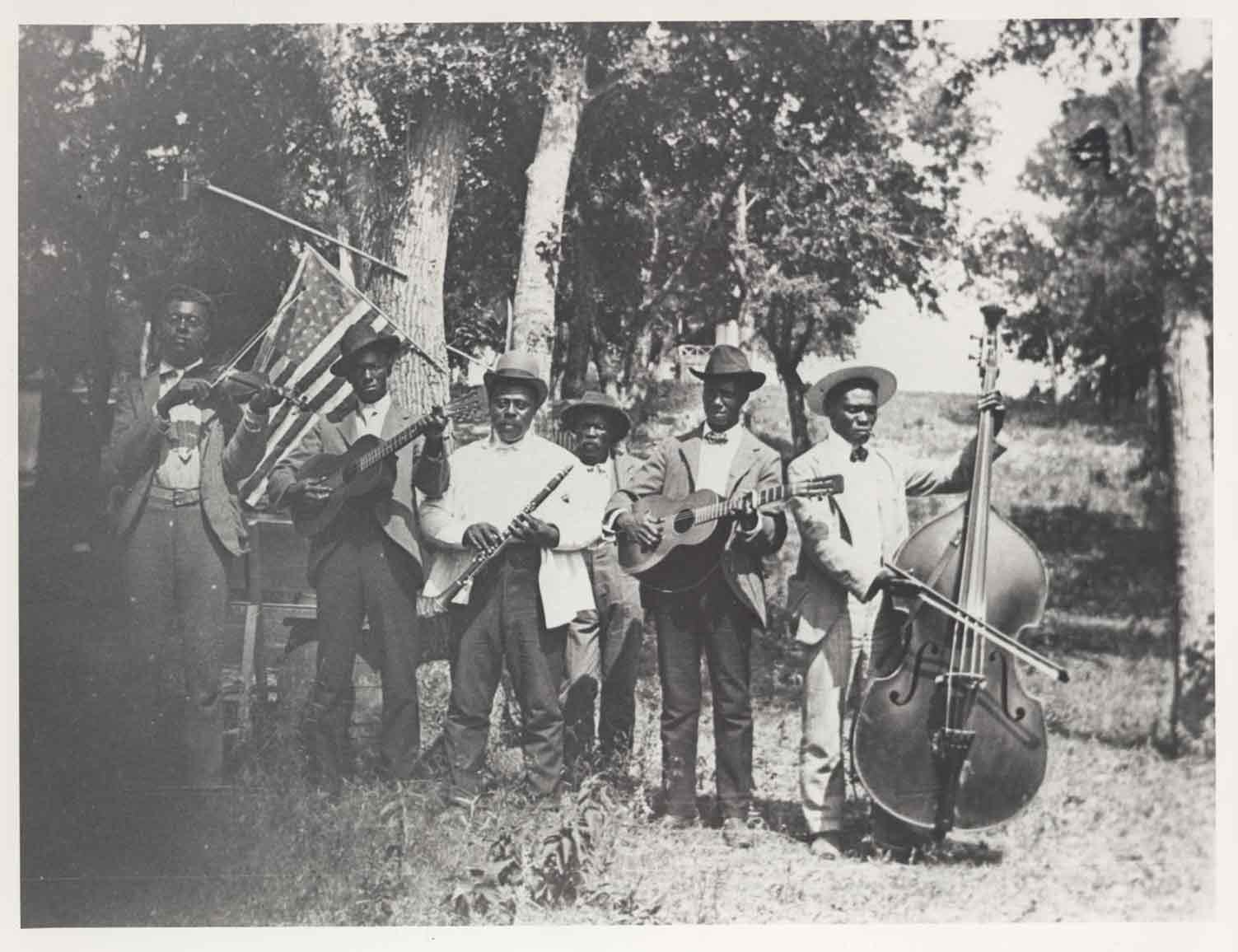
Credit: Austin History Center; This photograph depicts a band of performersthe June 19, 1900 Juneteenth celebration in “East Woods” on East 24th Street in Austin, Texas.
WEBSITE CONTRIBUTORS
Aldon Chen is a multidisciplinary designer, artist, and front-end developer based in San Francisco. He is currently pursuing a BS in Interaction Design at ArtCenter College of Design (ACCD), and previously studied Interactive Art at Maryland Institute College of Art (MICA).
Sarah Leiva is in the undergraduate class of 2024 at MICA pursuing interdisciplinary sculpture.
Font: "VT232" by Peter Hull
The Black Experience Mix by Koleco
Black Artist Research Space, Inc.